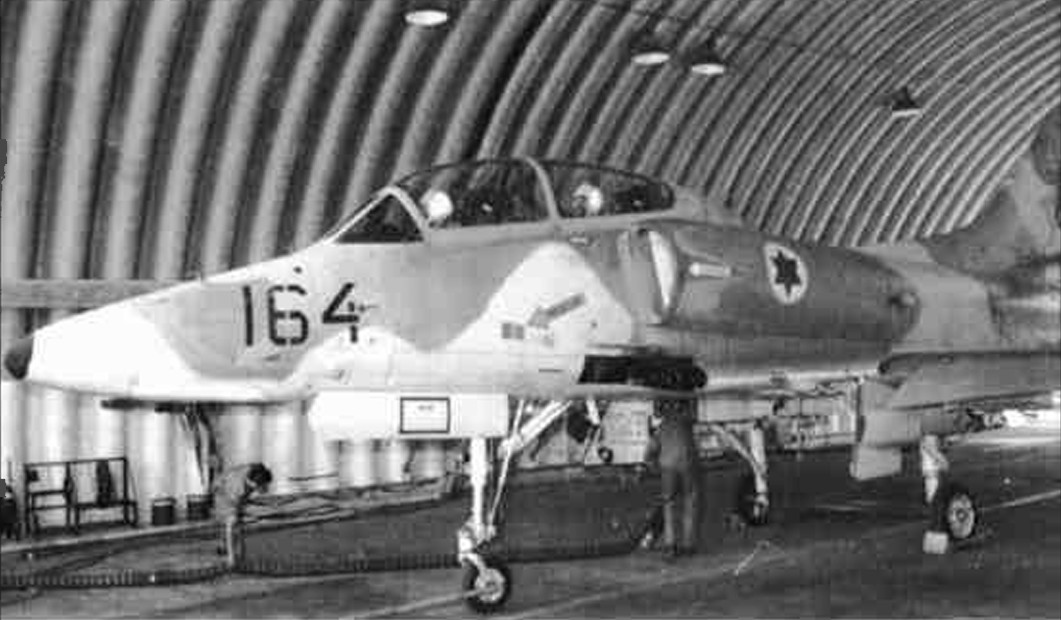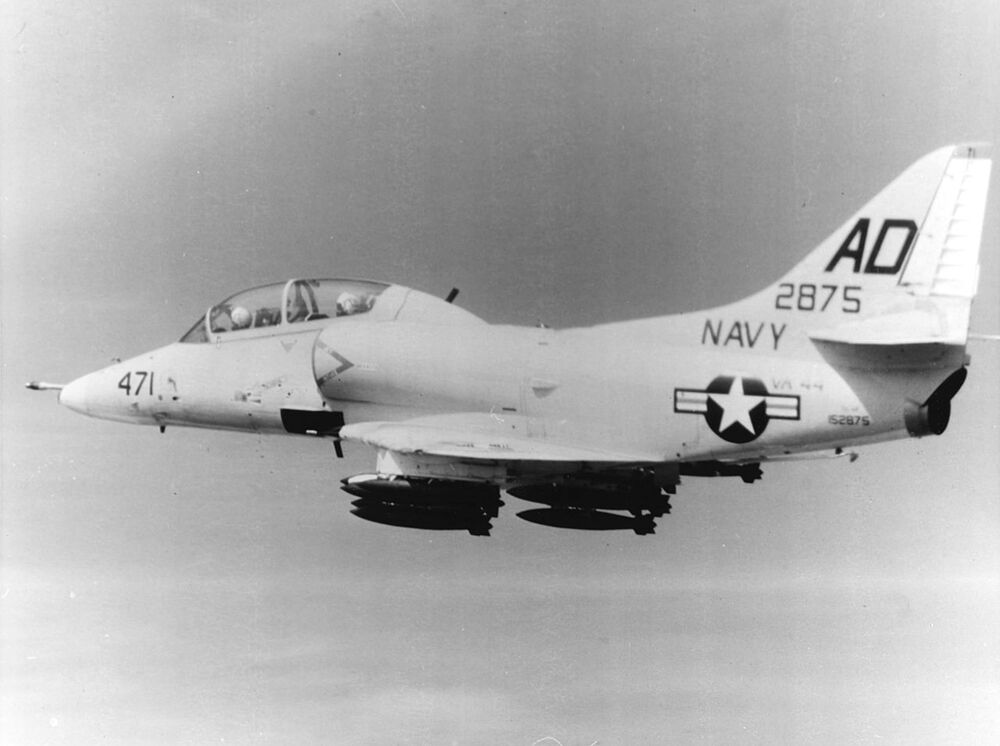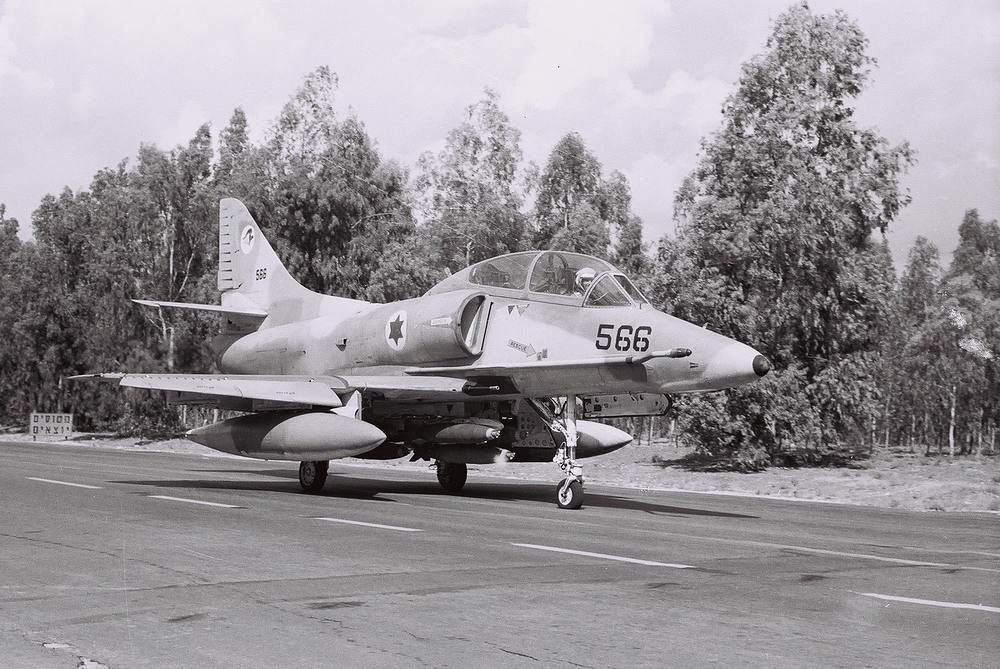- Yes
- No

Introduction
The Douglas TA-4F Skyhawk was one of two training model of the A-4 Skyhawk developed for the US Navy in the mid 60’s. It was designated as the more combat capable variant of the two retaining most of the features found on contemporary single seat models and seeing use in active combat theaters. As a very prolific user of the Skyhawk the Israeli Air Force acquired several examples of this variant where it had also served the same role.
The TA-4F Skyhawk in US Navy service.
History
The Douglas TA-4F and TA-4J were developed in the mid 1960’s in order to fill the need in the US Navy for an advanced tandem seat trainer. The TA-4F version specifically was designated as the combat configured version of the aircraft, retaining most (but not all) of the combat features from the single seat A-4F it was based on. The first airframe first took off on the 30th of June 1965.
The main differences between the TA-4F and it’s single seat counterpart (other than the additional seat) were the significantly lower fuel quantity and lack of AN/ALE-29A countermeasure blocks. It also appears as though some TA-4Fs lacked the IP-936/AXQ display used for operating TV guided weapons.
Several years later, The Israeli Air Force which had already acquired several dozen Skyhawks of it’s own export variation, the single seat A-4H and two seat TA-4H, required additional airframes in order to bolster it’s ranks from the erosion of it’s fleet due to accidents and the loss of several airframes during the War of Attrition fought against Egypt until 1970. With US-Israeli relations becoming ever warmer in those years the Israeli Air Force was able to sign a contract with the Americans to receive some 60 used ex-Navy A-4E airframes. This contract, as it turns out, had also included 4 ex-Navy TA-4Fs that have arrived in Israel in 1971.
In this photo is TA-4F number 64 under service with the 110th squadron in July of 1972. As can be seen in this photo, in comparison with the TA-4H variant that the IAF also had at time, the TA-4F lacked the brake chute mechanism under the engine nozzle and had a more rounded vertical stabilizer design.
In the Israeli Air Force the TA-4Fs received the number designations 64-67, and at the time of their arrival when the IAF changed it’s Skyhawk numbering to 3 digits the TA-4Fs received the 5XX prefix template to help indicate their variant. The TA-4Fs were moved between squadrons often based on requirements at the time, as can be seen with TA-4F number 64 being in the 110th squadron in 1972 and moving to the 116th squadron the next year. In the years leading up to 1972 the Israeli Air Force had also acquired some examples of the TA-4J variant which was the less combat capable variant, although externally they appeared identical to the TA-4Fs. The TA-4F just like the other 2 seater Skyhawks in the IAF was never converted to carry 30mm DEFA 553 cannons, instead retaining the 20mm Colt Mk.12s.
TA-4F Number 66 under service with the IAF flight school during the 1973 Yom Kippur War. In this photo the aircraft, loaded with six Mk.82 bombs and a pair of drop tanks, appears to be heading off to conduct a combat sortie.
During the Yom Kippur War of October 1973 all models of the Skyhawk in Israeli Air Force inventory were used in combat and that of course included the small number of TA-4Fs. What is quite unusual in regards to the TA-4Fs specifically however is that even though only 4 examples were present in IAF inventory, all but one of them were shot down by enemy fire, with two of them being lost completely and one barely making it back to a friendly airfield. On the 10th of October TA-4F number 65 piloted solo by Gal Ben-Ari under the 109th squadron was shot down at the Syrian front, with the pilot losing their life. On the 13th of October TA-4F number 67 piloted solo by Gabi Gerzon, also under the 109th squadron, was shot down at the Syrian front, this time the pilot managed to survive but was captured as a POW. In another instance during the war TA-4F number 64 piloted solo by Baruch Feldman under the 116th squadron was hit by a surface to air missile during a strike mission, barely managing to land the aircraft at Ramat David air base despite sustaining heavy damage to the tail section.
Based on circumstantial evidence, such as the rudder design that matches with that used by the 116th squadron, This appears to be a photo of TA-4F number 64 during the 1973 Yom Kippur war being evacuated by truck after managing to barely make it to Ramat David air base with a heavily damaged rear section due to a surface to air missile strike. This aircraft survived the war and was later repaired and returned to service.
In the years following the war the two TA-4Fs that survived it, number 64 and number 66 continued to serve alongside other Skyhawks. The TA-4Fs at that time period received the 1XX prefix template during a renumbering process that followed the conflict. It is unknown if the TA-4Fs received the same post-war modification package as the other 2 seater Skyhawks which would have given them a brake chute, an extended fiberglass tail pipe and countermeasure blocks. Unlike the other 2 seater Skyhawk variants in service neither of the TA-4Fs made it to retirement. On the 8th of March TA-4F number 66 piloted solo by Lt. Dov Cohen was destroyed in a fatal crash after Dov failed to recover the aircraft from a spin. On the 27th of May 1984 TA-4F number 64 piloted by Lt. Ilan Rozental and escorted in the back seat by Major Danny Gury caught on fire due to a fuel leak over a firing range. The two attempted to eject unsuccessfully and lost their lives in the ensuing crash. With that the TA-4F ended it’s service with the Israeli Air Force as the final one in service was destroyed.
In the Israeli Air Force museum today one of the aircraft on display is TA-4J number 747, a Skyhawk that originally served from 1970 as a TA-4F in the US Navy and was converted to a TA-4J in 1987. This TA-4 which was delivered to Israel in 1994 but had never actually entered service with the IAF as it was moved straight to storage, is the closest aircraft that still remains of what an Israeli TA-4F looked like in it’s original configuration.
Specifications
Type: Tandem Seat Trainer/Attack Aircraft
Country of origin: USA
Wing span: 8.38 meters
Length: 12.98 meters
Height: 4.76 meters
Powerplant: Pratt and Whitney J-52-P-8A rated at 4,218 kgf
Max speed: 1,085 km/h
Max altitude: 13,200 meters
Range: 2494 km
Weight: Empty - 4,993 kg, Fully loaded - 11,113 kg
Armaments: 2x20mm Colt Mk.12 cannons (100 round per gun for a total of 200), Mk.80 series bombs (including ones with Snakeye kits), M117 bombs, FFAR Might Mouse rockets, Zuni rockets, 20mm Mark 11 mod 5 cannon-pods, Mk.77 Incendiary bombs, AGM-12B/C bullpup, AGM-45 Shrike, AIM-9 Sidewinder (US Navy models).
Avionics:
- Refueling Probe
- APG-53A Radar
- ASN-41 Nav computer
- ARC-51A UHF Comm
- ARR-69 UHF AUX Rec
- APX-64 Radar IFF
- APN-153 Doppler Navigation Radar
- TACAN ARN-52
- ARA-50 ADF (UHF)
- ARN-141 Radar Altimeter
- AN/AJB-3A LABS and CP-741 Weapon Delivery Systems (CCRP)
- Provisions for JATO (Jet Assisted Takeoff) boosters
Sources
Spoiler
https://www.isradecal.com/product-page/iaf-a-4-ayit-in-service-with-109-110-squadrons
Israeli A-4 Skyhawk Units in Combat (Combat Aircraft, 81): Aloni, Shlomo, Laurier, Jim: 9781846034305: Amazon.com: Books
סקייהוק - מרקיע שחקים
IDF/AF A-4 Skyhawk Facebook group
מטוסי חיל האויר מהטייגר מות' עד הסופה
Air War on the Edge: A History of the Israel Air Force and It's Aircraft Since 1947: Norton, Bill: 9781857800883: Amazon.com: Books
McDonnell Douglas - TA-4F & TA-4J Two-Seater Skyhawks - REPORT MDC-J4176 May 1st 1972
Standard Aircraft Characteristics Navy Model TA-4F Aircraft NAVAIR 00-110AA4-7
Supplement to NATOPS Flight Manual Navy Model A-4E/F International Model A-4K aircraft NAVAIR 01-40AVK-1




